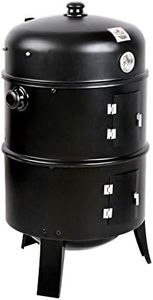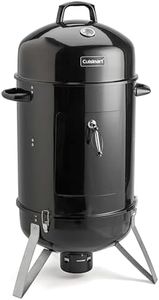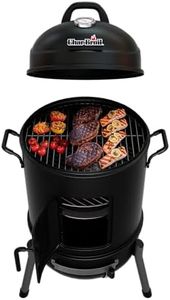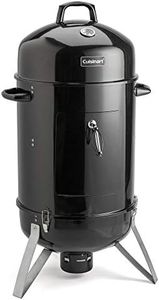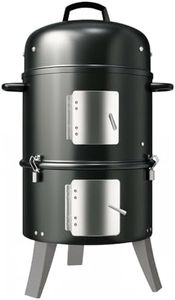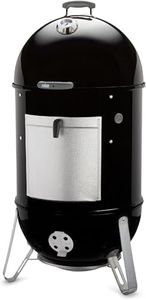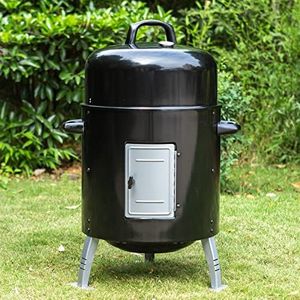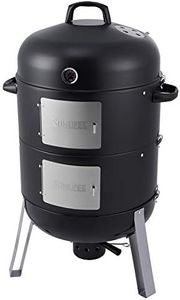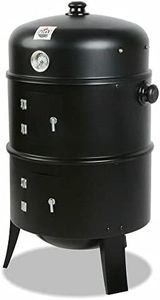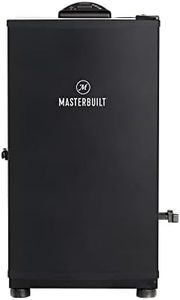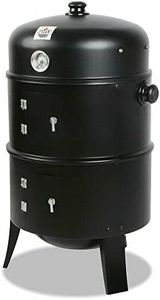We Use CookiesWe use cookies to enhance the security, performance,
functionality and for analytical and promotional activities. By continuing to browse this site you
are agreeing to our privacy policy
10 Best Vertical Smokers
From leading brands and best sellers available on the web.Buying Guide for the Best Vertical Smokers
Choosing the right vertical smoker can really enhance your outdoor cooking experience by offering a convenient way to produce delicious smoked foods like ribs, brisket, or even vegetables. When shopping for a vertical smoker, it’s important to focus on your actual cooking needs, the space you have available, and how hands-on you want to be during the smoking process. Understanding a few key specifications will help you match a smoker to your personal cooking style, the amount of food you want to prepare, and how often you’ll be using it.Fuel TypeThe fuel type of a vertical smoker refers to the source of heat and smoke it uses—commonly charcoal, electric, gas, or wood pellets. This affects the flavor of the food, ease of use, and where you can use the smoker. Charcoal and wood smokers usually deliver richer smoky flavors but require more active monitoring and skill. Electric and gas smokers are easier to use, offering more consistent temperatures with less attention needed, and are usually quicker to start. To pick the right one, consider whether you value intense smoke flavor and hands-on cooking, or if you prefer convenience and ease of use.
Cooking CapacityCooking capacity refers to how much food the smoker can handle at once, usually described by the number of racks or total square inches of cooking space. Smaller capacities are ideal for singles, couples, or small families; mid-sized models work well for moderate gatherings; while large capacities are needed if you regularly host bigger groups or want to smoke large cuts of meat at the same time. Think about how many people you typically cook for and let that guide your choice.
Temperature Range and ControlThe temperature range and how easy it is to adjust or hold temperatures are important to get the results you want. Some smokers hold low and slow temps very well, which is perfect for traditional barbecue, while others can reach higher temperatures for a broader range of foods. Manual dampers and vents are common for charcoal and wood smokers, while electric and gas units might have thermostats or dials for easier adjustment. If you need simple operation and consistency, look for models with more automation and better insulation; if you enjoy tweaking the process, more basic models give you more direct control.
Build Material and InsulationThe material and insulation of a vertical smoker affect its durability and its ability to maintain steady temperatures, especially in colder or windy weather. Heavier gauge metals and good insulation keep heat steady and improve fuel efficiency, while cheaper thin metal models may lose heat and smoke more quickly. If you plan to use your smoker year-round or in variable climates, prioritize models with better insulation and sturdy builds.
Ease of Cleaning and MaintenanceHow easy it is to clean your smoker can make a big difference in how enjoyable it is to use in the long run. Removable ash pans, grease trays, and accessible interiors make cleanup quicker and less messy. Consider your willingness to clean after each use—if you prefer a quick and easy process, look for features that allow you to detach and wash components easily.
Portability and SizePortability and the overall footprint of the smoker are important if you have limited space or want to move your smoker between storage and your cooking area. Smaller, lighter models are good for tight patios or regular transporting, while larger, heavier options might be better if you have a permanent setup. Assess where you’ll keep and use the smoker to ensure it fits your space and lifestyle.
